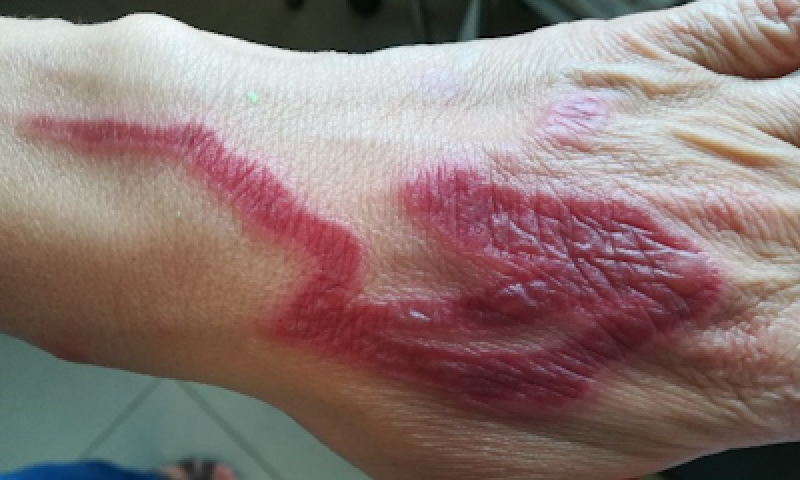Serpentine supravenous dermatitis is a rare eruption related with cytotoxic drug infusion. Several chemotherapeutic agents have been related with this entity. But, most of the published cases are caused by docetaxel. However, considering the high frequency of administration in oncology this rather unknown eruption should be known to all physicians, especially oncologist, dermatologist, internist and GP.
The diagnostic, in this case, was made by teledermatology. Teledermatology is a subspeciality of dermatology that uses telecommunication technologies to transfer medical information (pictures of skin, lesions or rashes) to a specialist for advise on diagnosis or management. It is a way for primary care doctors to get an opinion from a specialist dermatologist without having to refer patients through the normal referral pathway.
In this case, teledermatology was especially useful because it allowed us observing the lesions at the time of onset.
A 53-year-old woman, with a previous history of Hodgkin's lymphoma more than thirty years ago, was diagnosed with breast carcinoma. She was treated with docetaxel with a dose of 100 mg mg/m2 + cyclophosphamide (600 mg/m2) cycled every 21 days. The patient had premedication with oral dexamethasone (20 mg), ranitidine (50 mg), ondansetron (8 mg) and dexchlorpheniramine (5 mg).
She presented to her general practitioner with a linear, erythematous and pruritic eruption on the back of her left hand, six days after receiving chemotherapy infusion at this location. There were no systemic symptoms. The physician treated her with oral dexamethasone and cetirizine and cited her 3 days later. After treatment, the lesión bécame violaceous and with minimal inflammation.
Then, the general practitioner consulted us by teledermatology. The Figure 1 (first day of the consultation with her doctor) showed an erythematous-bullous plaque with linear extensions following the route of the superficial venous network of the dorsal aspect of her left hand. The Figure 2 (after the treatment) exhibited that the lesión had become less inflammatory with a residual aspect.
 Figure 1: Serpentine supravenous dermatitis at the dorsum of the left hand after chemotherapy with docetaxel and cyclophosphamide.
View Figure 1
Figure 1: Serpentine supravenous dermatitis at the dorsum of the left hand after chemotherapy with docetaxel and cyclophosphamide.
View Figure 1
 Figure 2: Evolution of the lesion several days later, after dexamethasone treatment.
View Figure 2
Figure 2: Evolution of the lesion several days later, after dexamethasone treatment.
View Figure 2
Based on the clinical pattern a diagnosis of supravenous serpentine dermatitis was made and communicated to the oncology department. Nothing had to be done because it was her last cycle of chemotherapy. The lesion resolved in two weeks with hyperpigmentation.
Serpentine supravenous dermatitis or persistent supravenous erythematous eruption or serpentine supravenous hyperpigmentation are used to name this in frequent cutaneous eruption. The lesions typically appear between 24 hours and 15 days after intravenous cytotoxic drug infusion. The hyperpigmentation is usual after resolution [1].
The pathophysiology of this process is unknown but, a direct cytotoxic effect of the drugs on the vascular endothelium is suspected. This toxicity may increase the vascular permeability so that, the drug may produce a direct toxic effect on the epidermis [2].
Several agents, alone or in combination, can cause it, such as nitrogen mustard, nitrosoureas, 5-fluoracil, cyclophosphamide, actinomycin, doxorubicin, vinca-alkaloids, vinorelbine, taxanes, docetaxel, methotrexate, daunorubicin, dacarbazine [1].
Our patient was treated with two of the drugs related to this entity, docetaxel and cyclophosphamide. Either could cause it alone, or the combination of both. Serpentine supravenous dermatitis is not a frecuent side-effect of chemotherapy and most publications are single cases [1-4]. Many of these cases are docetaxel related. Just another case was treated with docetaxel and cyclophosphamide like ours [4].
In conclusión, this case shows a rare effect of the chemotherapy that dermatologists should know. We also want to emphasize the usefulness of teledermatology for the acute eruptions. This case teaches us that sometimes an image and medical history can give the diagnosis. In this increasingly digitized world, teledermatology can be an interesting additional tool to support timely diagnosis and treatment in patient care.